During the past couple of years, NFT has become one of the 21st-century buzzwords. NFTs have gained a lot of hype as a form of digital art that sells for millions of dollars.
To make sure you don’t miss out on the crypto and NFT conversations, here is a complete list of the most common terminology related to NFTs.
WAGMI, just remember to DYOR to avoid being rugged.
What Is an NFT?
NFT stands for Non-Fungible Token.
In a nutshell, NFT is something that cannot be replaced. It is like a one-of-a-kind playing card.
However, an NFT is not something physical. Instead, it is a digital token that lives on the internet.
Something like a US Dollar is fungible. You can give me one dollar and I can give you back a different one. The value is still the same.
However, a non-fungible token is something that cannot be replaced. It is a unique token characterized by a unique ID. There can be only one NFT of that kind.
What Gives an NFT Its Value?
When an NFT enthusiast purchases an NFT, they believe its value will go up over time.
In other words, purchasing an NFT is an investment.
Due to the massive hype and the easiness to trade NFTs, the assumption of the price going up is not stupid at all.
There are some examples of NFTs, such as CryptoKitties, whose value has exploded. These NFTs have been traded for hundreds of millions of dollars.
Anyway, the value of an NFT is formed the same way any other piece of physical art gets value.
Where Do NFTs Live?
NFTs are bits that live on the internet.
Most of the NFTs live in the decentralized Ethereum blockchain.
If you purchase an NFT, you become the true owner of it.
This ownership is verified and supported by the entire Ethereum network. No central authority is involved.
Blockchain technology and the lack of central authority are the main factors driving interest in cryptocurrencies and NFTs.
You cannot use regular money to buy NFTs.
Instead, you need to use cryptocurrency, like Ethereum.
Furthermore, you need to use an NFT marketplace, like OpenSea to successfully make a purchase.
What Can Be an NFT?
Anything digital can be turned into an NFT.
It can be a song, video, or video.
The most popular NFTs at the moment belong to PFP NFT collections (more on that later in this article). The hype around these is unbelievable.
1. AIRDROP
Airdrops are free collectibles offered by the creators of a particular NFT collection.
Two common reasons why someone would do an airdrop are:
- Create additional interest in the NFT project to build more hype.
- Reward a member or members of the community based on some criteria, such as doing a social media post.
To put it short, an airdrop is a free piece of NFT.
2. ALPHA
Alpha is a secret future announcement.
In layman’s terms, it refers to insider information about an NFT project.
A reason why a future announcement is kept confidential is to avoid price manipulation of an NFT collection.
A person who is somehow able to figure out the alpha(s) can invest early on in the project.
Knowing an alpha and investing early practically guarantees a positive return on investment.
3. ASSET
Asset refers to a digital collectible, such as an NFT or Cryptocurrency.
4. BURST
BURST refers to a widely known NFT asset that any typical collector would like to buy.
5. BEEPLE
Beeple is an alias for the most popular digital artist, Mike Winkelmann.
Beeple created a piece of digital art that sold for $69,400,000. This is the record for the highest price ever paid for digital art.
You can find more info about the artwork here: Everydays: the First 5000 Days.
6. BITCOIN
Bitcoin is the most popular cryptocurrency on the planet.
The main purpose of Bitcoin is to serve as an investment vehicle for stored value.
However, people and companies are using Bitcoin for instant payments more and more. This is due to the highly secure peer-to-peer network Bitcoin operates.
As opposed to regular currency (Fiat currency), there are no physical Bitcoins. All the balance is kept on a public ledger. Furthermore, anyone has access to this public ledger.
7. BLOCKCHAIN
Blockchain is a digital ledger. It stores data across a global network.
A blockchain ledger is publicly verifiable and unchangeable. This means anyone can access the nodes in a blockchain.
In other words, there is no central authority as a middleman controlling the blockchain.
Blockchain technology powers cryptocurrencies. It allows secure transactions to take place.
In case you are wondering, a Bitcoin blockchain is a public record of all the transactions ever made. Anyone can access and read this ledger.
Thus the “list of transactions” is not anonymous.
However, the blockchain transactions are encrypted with Public Key Cryptography. This way all the public transactions are masked in a way that it hides the identities of the people behind the transactions.
8. BRIDGE
Bridge or bridging means moving NFT tokens from one blockchain to another.
This typically costs a fee.
In practice, this works by the following procedure.
- A user deposits a piece of NFT into a smart contract in Network A.
- The NFT is locked.
- The user gets signatures from oracles that confirm the deposit to Network A.
- The user then uses these signatures in Network B to call the same smart contract and mint the duplicate NFT there.
- The piece of NFT is now minted as a “bridged collection” in Network B.
To put the original NFT back in Network A:
- The user must send the duplicate NFT in Network B to the bridge.
- The duplicate NFT is burned on the bridge.
- The oracles return new signatures to verify this happened.
- The user uses the new signature to call the smart contract in Network A where the original piece of NFT gets released.

9. BTC
BTC is an abbreviation for Bitcoin, the most popular cryptocurrency on earth.
10. BURNING
Burning means destroying an NFT.
Your NFT marketplace makes it easy for you to burn NFTs.
However, it is good to understand what it means in practice.
Under the hood, burning means sending the NFT to an unspendable address. In other words, your piece of NFT does not actually get destroyed. Instead, it becomes unusable.
This action cannot be reversed.
Notice that transactions that took place before burning will remain in the blockchain forever.
After burning an NFT token, a Proof of Burn (PoB) is created to verify the burning action.
11. BUYER
A buyer in the NFT/Crypto space means someone who is trying to make a profit by buying and selling digital collectibles.
The idea is exactly the same as in the real world.
12. CAT
CAT is an abbreviation for Crypto collectible Asset Token.
This, in turn, refers to CryptoKitties, which is one of the most traded NFT collections to date.
13. COLLECTIBLE
In NFT space, a collectible refers to a unique piece of digital art that holds an intrinsic value.
A collectible can be a song, video, picture, or any other unique digital item.
14. CDS
CDS or Community Designated Seller is someone who sets up a private address dedicated to people looking to sell their digital collectibles.
15. CROWD SALES
Crowdsale is a public offering to invest in a new digital asset, such as a cryptocurrency or NFT.
Crypto companies sometimes organize crowd sales to raise money for their crypto project.
The money made by crowd sales can be invested back in developing the business related to NFT/cryptocurrency.
If you want to invest in a crowd sale crypto/NFT, it is important to do enough research about the project and to understand the risks involved.
16. CRYPTO
Crypto is a shorthand name for cryptocurrencies.
This likely originates from the fact that the word “cryptocurrency” is a long word.
17. CRYPTOPUNKS
CryptoPunks deserves its own spot in this list due to its popularity and high trading value.
CryptoPunks is a popular NFT collection.
It consists of cartoon-like punks with different outfits and facial traits.
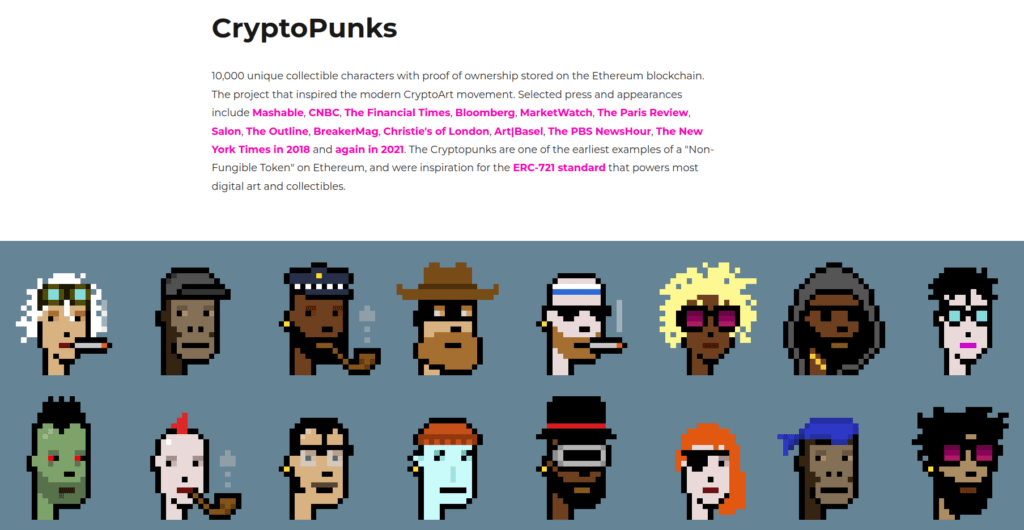
Three of the CryptoPunks collection made it to the Top 10 Most Expensive NFTs.
18. CRYPTO COLLECTIBLES
Crypto collectibles refer to collectibles that are part of a blockchain. A piece of NFT art is an example of crypto collectibles.
In the context of NFTs and Crypto, the words collectible and crypto collectible are used interchangeably.
19. CRYPTOCURRENCY
Cryptocurrency is a decentralized currency.
Decentralized means there is no central authority, like a bank, that handles the currency.
Cryptocurrencies usually operate on blockchain technology.
The word “crypto” originates from the word cryptography. Blockchains use public-key cryptography to encrypt transactions. This makes the system secure.
Due to cryptography, it is next to impossible to counterfeit or steal cryptocurrency.
20. DAO
DAO is an abbreviation for Decentralized Autonomous Organization.
It is an entity owned and run by its members, instead of a central authority.
In a DAO, each member has an equal say when it comes to decision-making.
One way to describe a DAO is to think of it as a club for crypto enthusiasts. It is a group of members that have a shared goal.
A DAO is built on a blockchain using smart contracts.
To join a specific DAO one usually has to buy their way in to get a governance token. This token verifies you are part of the community and have a say in decision-making.
The DAOs can consist of people from all across the world.
Usually, communication is made through Discord channels.
21. DYOR
DYOR is a shorthand for “Do Your Own Research”.
When it comes to investing in crypto-collectibles, doing research is an important part of the process.
This is to mitigate the risks.
Oftentimes you hear people discuss cryptos and NFTs on Reddit, Discord, or other similar platforms. When crypto enthusiasts share their own opinions, they might say “DYOR” at the end of a message. This is to highlight the fact that this is just their personal opinion, and you should conduct further research before investing.
For example:
“This NFT is blowing up. It has all the elements and hype to it. DYOR, though.”
22. DAPPS
DApp is an abbreviation for Decentralized App.
Similar to DAO (earlier in this list), a decentralized app is an app with no central authority.
In a regular app, the backend runs on a server provided by a central authority like Facebook or Instagram.
The backend of a dApp runs on a peer-to-peer network, that is, on a blockchain. Thus, the servers do not belong to a company. Instead, they belong to the community.
The benefits of dApps include:
- Zero downtime. The network is always up and running.
- Privacy. No real-world identity is needed.
- No censorship. No single entity on a network can block its users from taking action.
- Data integrity. The data stored on a blockchain cannot be changed later on.
- Trustlessness. No need to trust a central authority to handle our data the right way.
23. DEFI
DeFi is an abbreviation for Decentralized Finance.
The idea behind decentralized finance is to disarm the financial power of central authorities like banks and other financial institutions.
DeFi is based on peer-to-peer networks, similar to the ones used by cryptocurrencies.
24. DECENTRALIZED EXCHANGES (DEX)
A Decentralized Exchange or DEX is a cryptocurrency exchange.
It allows transactions to be made without a central authority, like a bank.
Crypto transactions are carried out by smart contracts.
25. DEGEN
Degen is an investing style that involves high risk and a lot of speculation. Commonly, the verb degen is also used as a noun to describe a person who practices this style of investing.
“Degens are going to ape in soon.”
The word degen originates from degenerate.
A degen has a negative association to it. This is because a degen bases the risk analysis on luck instead of putting in the work and doing the research.
Degens typically rush in to buy popular NFTs that other investors are buying without researching. A typical degen has a fear of missing out (FOMO) when it comes to investing in popular/trending NFTs.
26. DIAMOND HANDS
In the NFT space, the word “hands” refers to the way an investor holds their NFTs.
Diamond hands mean you are determined to keep the NFT assets no matter how long it takes before you make a profit.
Someone with diamond hands can single-mindedly hold on to their NFTs for years without panic-selling them.
See also “Paper hands” later on in this list.
27. DISCORD
Discord is a popular social media platform in gaming and NFTs.
Most of the popular NFT projects have their own Discord channel where anyone can join for engagement and stay up to date with the project.
28. DROP
The drop means releasing new NFTs to the market.
Purchasing NFTs during the drop is a great way to save money.
You can hear about NFT drops through:
- Word of mouth
- Social Media
- DMs
- NFT marketplace news
29. ERC-721
ERC-721 is a recipe for building NFTs on the Ethereum Virtual Machine compatible blockchains.
- ERC stands for Ethereum Request for Comment
- 721 is the identifier number of the proposal
There are lots of these ERC proposals.
In particular, the ERC-721 proposal has become a popular open standard for building NFTs. This is because it specifies a set of rules that makes it easy to work with NFTs.
30. ETH
ETH is an abbreviation of Ethereum.
Ethereum blockchain is really popular and it is used to store all the NFTs.
31. ETHER
Ether is an altcoin that runs on the Ethereum blockchain.
Ether tokens are used to perform transactions in the Ethereum dApps.
To better understand what this means, consider a dApp on the Ethereum blockchain. In this dApp, you can send and edit messages on a channel.
To make these transactions possible, dApp needs processing power.
But this processing power is not free.
To back up the costs of the processing power, you need to pay a fee each time you make a change to the network. This fee is paid using Ether tokens.
32. ETHEREUM
Ethereum is a decentralized blockchain platform. It is best known for its cryptocurrency, Ether (ETH).
ETH is the second most popular cryptocurrency after Bitcoin.
Ethereum blockchain makes it possible to use Ether for secure transactions on the blockchain using smart contracts.
33. ETHERSCAN
Etherscan is a website that functions as an Ethereum blockchain network explorer.
You can access transactions, blocks, wallet addresses, smart contracts, and more. These can help you understand your intercourse with the Ethereum blockchain, wallets, or dApps.
Etherscan helps you stay safe and detect suspicious actions.
34. EXCHANGE
To trade your crypto assets for other crypto assets, you have to use an exchange, such as Binance.
Crypto exchanges allow you to use regular credit cards too.
35. FOMO
FOMO stands for “fear of missing out”.
This term is widely used in different contexts.
In the crypto/NFT space, FOMO refers to the fear of missing out on buying assets whose value could rise.
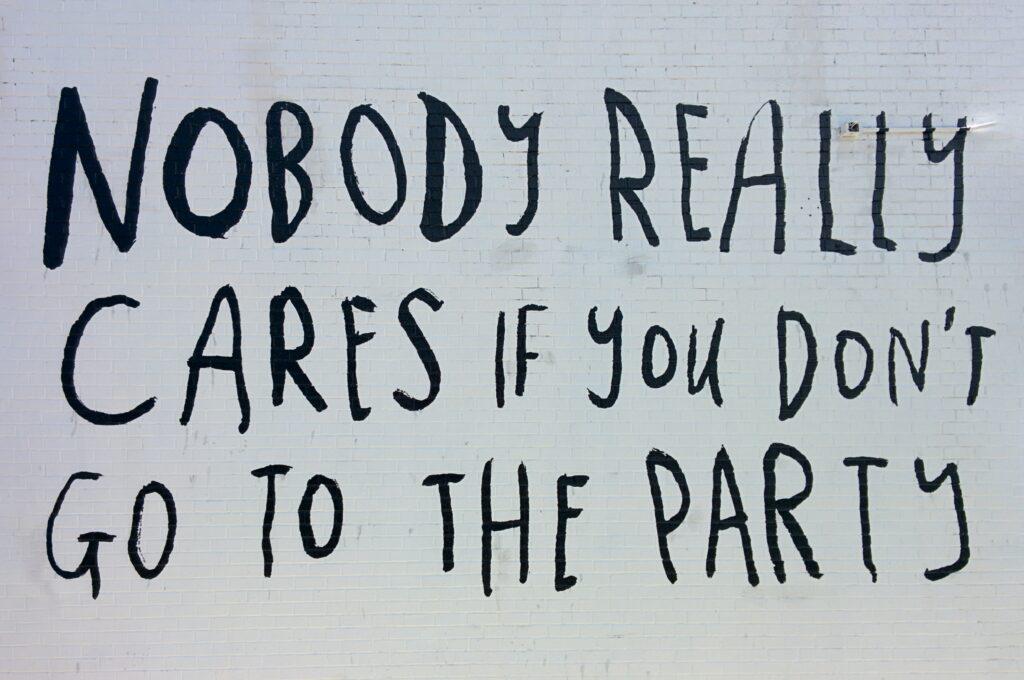
36. FUD
FUD is an acronym for Fear, Uncertainty, and Doubt.
FUD is typically created when:
- Someone spreads negative and potentially incorrect information on a crypto/NFT project.
- There is a general bad smell on the future of a crypto/NFT project.
A related term, fudder, is someone who is going through the FUD.
37. FARMING
NFT farming is a relatively new concept to make money with NFTs on the DeFi market.
In farming you either:
- Stake an NFT to receive tokens as a reward.
- Stake tokens to receive NFT as a reward.
38. FIAT
Fiat currency is the “regular currency” issued by the government.
Examples of fiat currencies are the paper currencies like US Dollar, Euro, or any other major global currency.
A fiat currency is not backed by any physical commodities such as precious metals. Instead, a fiat currency’s value depends on:
- The relationship between supply and demand.
- The stability of the government.
39. FLOOR
The floor is the lowest current market price of an NFT project.
For example, consider an NFT collection with 10,000 assets. The floor is the price of the cheapest NFT in the collection.
“I should have bought CryptoKitties when the floor wasn’t that high.”
40. FRACTIONAL OWNERSHIP
Fractional ownership means you do not own the entire NFT. Instead, you own a fraction of it.
More often than not, NFTs are owned by a single owner.
However, the new variant called fractional NFT makes it possible to own a fraction of a piece of NFT.
41. FUNGIBILITY
Fungibility means replaceability.
A British Pound is fungible. You can swap any two pounds and still own a pound.
On the other hand, paintings are not fungible. There is only one painting of that kind. Nothing can replace it.
42. FUNGIBLE TOKENS
A fungible token is a changeable token on a blockchain.
A Bitcoin is an example of a fungible token. Each Bitcoin has the same value as any other Bitcoin out there.
43. GPU
GPU is the graphics processing unit on a computer.
The GPU’s computational power can be used to mine cryptocurrencies, such as Bitcoin or Ethereum.
This is because mining a cryptocurrency means solving heavy maths problems to verify transactions on a blockchain.
44. GAS
Gas or the gas fee is the fee to pay for a successful transaction on the Ethereum blockchain.
The gas fee is charged every time you make a change to the Ethereum network, such as when you:
- Buy an NFT asset.
- Send Ethereum.
- Create a smart contract.
45. GENERATIVE ART
Generative art means a computer program randomizes pre-built image layers to create the NFT art images.
For instance, take a look at the Pudgy Penguins NFT collection:
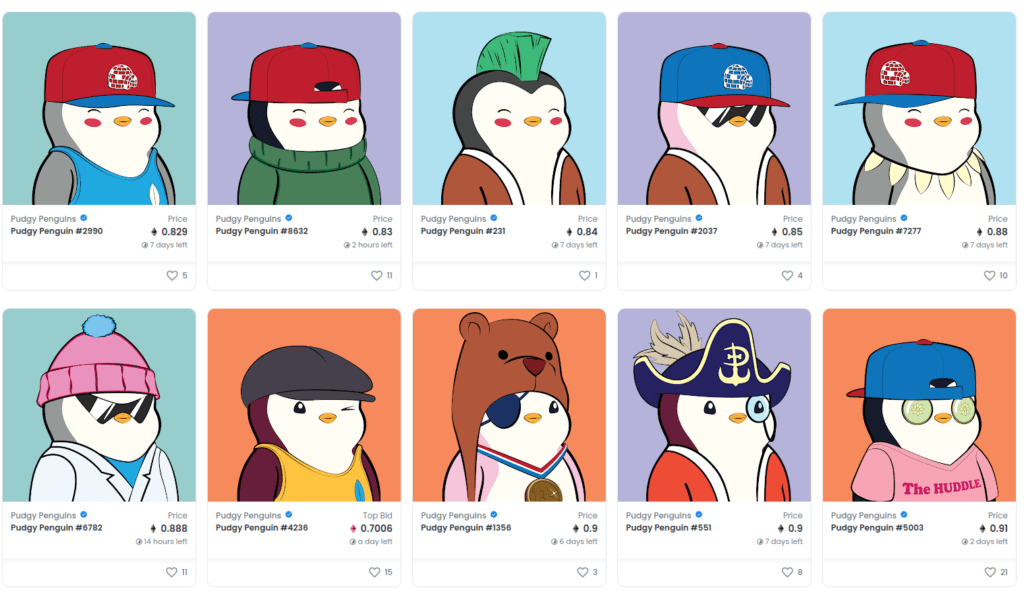
In this NFT collection, there are 8,887 separate NFTs.
But the artist did not create each image separately. Instead, the artist drew a bunch of components that were randomized by a program 8,887 times.
If you take a closer look at the NFT artwork, you see that the images look similar.
- Each image has the same “base” penguin.
- However, the eyewear, hat, jacket, and almost everything else varies from image to image.
The NFT images are generated by a computer program that randomly adds layers upon layers to form the images.
This streamlines the process of creating the NFT artwork.
As an artist, you only need to draw a bunch of layers and let the program take care of the rest.
For example, if you have 5 hats, 4 glasses, and 10 jackets, you can generate 5 x 4 x 10 = 200 combinations, where the avatar wears a different hat, glasses, and jacket.
- Make sure to read The Best NFT Art Generating Tools.
46. HASHMASK
Hashmask is a popular digital art collective put together by Wolfgang Beltracchi.
The story behind this man is that he spent time in prison due to forging and selling famous artists’ arts for decades.
This gave him bans to all museums, galleries, and auction houses from selling his work.
Lo and behold, Beltracchi created an NFT collection that has gained a lot of popularity.
47. HASHRATE
The hashrate is a measure of computational power being used on a blockchain.
It is a key security indicator.
A blockchain with a high hashrate is more secure. This is because it would require more effort to successfully attack the blockchain.
Potential investors can use the hashrate to get an idea of the health of the blockchain.
48. ICO
ICO stands for the Initial Coin Offering.
In the crypto world, the ICO is equivalent to the IPO (Initial Public Offering).
ICO is a way to raise funds for the project. This is because ICO makes it possible for investors to purchase new cryptocurrency tokens.
The initially offered crypto tokens can have some usefulness related to the project, or they can represent a small stake in the company/project.
49. INTERPLANETARY FILE SYSTEM
An Interplanetary File System (IPFS) is a peer-to-peer file-sharing network. IPFS aims to take us a step closer to the decentralized web.
IPFS offers a better way to store NFT data in comparison to an HTTP gateway URL. This is because the latter means your NFT data is stored on a central authority’s servers, and thus relies on it.
When using an IPFS, the data can be found as long as the address is hosted by someone in the decentralized P2P network.
50. KYC
KYC stands for Know Your Customer.
The blockchain companies ask you to fill in lengthy forms where they ask for your name and other personal info.
This is to comply with the KYC regulations.
51. METAMASK
Metamask is a digital wallet used to access NFT marketplaces, such as OpenSea or Rarible.
It is used as a browser extension.
With MetaMask, you can:
- Store Ether tokens in the MetaMask wallet.
- Interact with dApps in the Ethereum blockchain.
52. METADATA
Metadata in general means data about the data. It provides information on the data.
Any piece of digital art is associated with metadata. This could be:
- Name of the file
- Size of an image
- Length of a video
And much more.
53. METAVERSE
Metaverse is a virtual 3D world. It is a digital, alternative universe where people can interact with one another as 3D avatars.
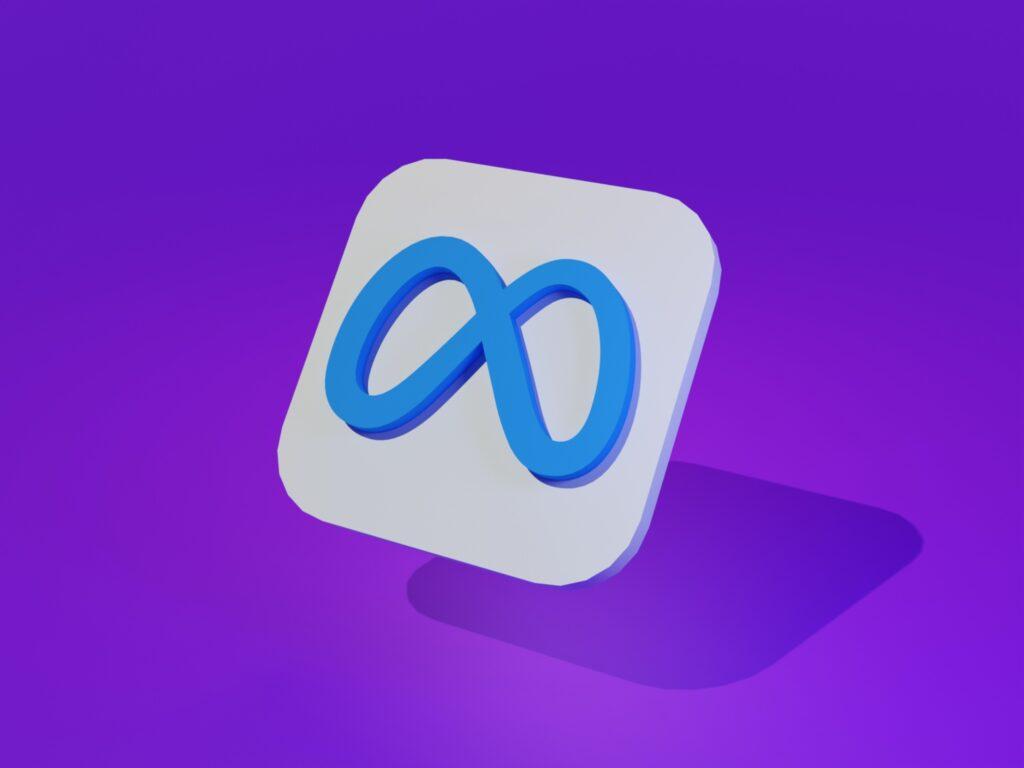
54. MINING
In the crypto space, mining means performing calculations to add a new unit of cryptocurrency into a blockchain.
When this happens, the miner gets an award, which is a small amount of cryptocurrency.
Due to the complexity of the mathematical problems to be solved, mining is usually not done alone. Instead, a miner joins a pool of miners to give the computational power to it. If a mining pool successfully mines a reward, it is then shared with the members of the pool.
55. MINTING
Minting means producing something new.
In the crypto/NFT space, minting means:
- Validating information.
- Creating a new block based on the validated info.
- Adding the block into the blockchain.
As a concrete example, you can mint NFTs.
This simply means adding new NFTs to the blockchain.
A minted NFT can then be purchased by someone else in the network.
56. MINTING INTERVAL
The minting interval describes how often you can mint new tokens into the blockchain.
57. NFA
NFA is an abbreviation for Non-Financial Advice.
“I think CryptoKitties price will continue to rise. NFA, though.”
58. NFT
NFT stands for Non-Fungible Token.
A non-fungible token means an irreplaceable token on a blockchain.
An NFT can be anything digital, such as an image, video, or song.
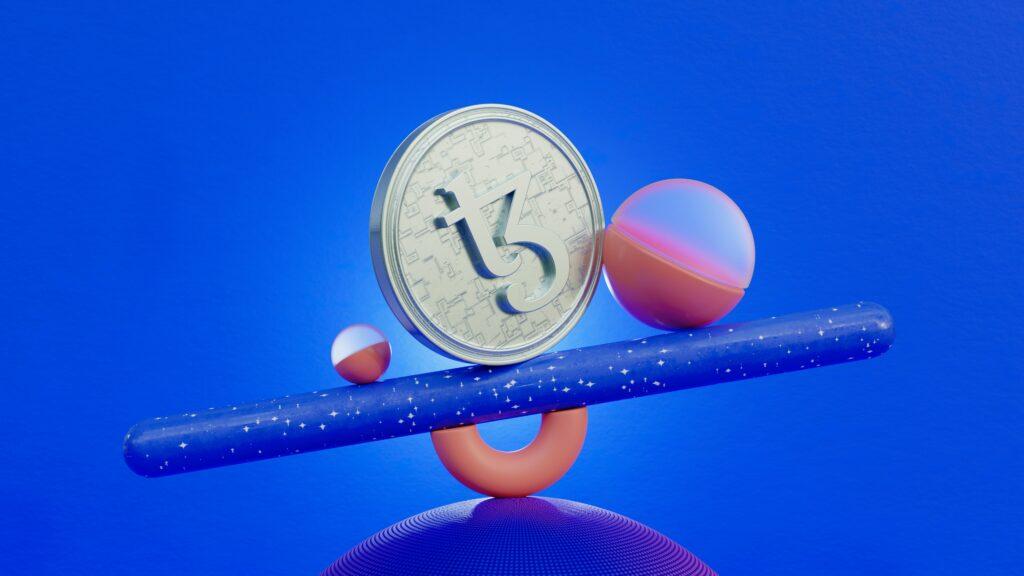
59. NGMI
NGMI is a shorthand for saying Not Going to Make It.
This acronym is called for someone making bad decisions or using poor judgment.
In the NFT/crypto space, NGMI is used to highlight the fact that someone, usually with paper hands, is about to miss a huge opportunity on a trade.
60. NIFTY GATEWAY
Nifty Gateway is a popular NFT marketplace where you can purchase and sell digital collectibles.
The word “Nifty” is a playful term that refers to NFT.
The Nifty Gateway operates on the Ethereum blockchain.
61. NONCUSTODIAL WALLET
A non-custodial crypto wallet gives you full control over your keys and funds.
This is a no-third-party solution when it comes to storing your crypto assets.
Instead of relying on a third party, you have to trust yourself not to mess things up with a non-custodial wallet. This means you have to make sure not to:
- Lose the wallet.
- Destroy the wallet.
- Forget a password.
Unless you have taken proper precautionary steps for these situations, you are going to lose access to your digital funds.
An example of a non-custodial wallet is the MetaMask browser extension.
62. NOOB
You probably guessed it already. A noob or a newbie is someone new to the NFT/Crypto thing.
63. OFF-CHAIN METADATA
Off-chain metadata is metadata that is not publicly accessible. It is stored outside of the blockchain.
When NFT projects store metadata off-chain, they do this because of the limitations in the Ethereum blockchain.
64. ON-CHAIN METADATA
On-chain metadata is metadata that is integrated directly into the smart contract that makes up the tokens.
65. OPENSEA
OpenSea is the most popular NFT marketplace.
You can trade the most popular NFTs on the OpenSea marketplace, including:
- CryptoKitties
- CryptoPunks
- PudgyPenguins
And much more.
66. PFP
The PFP stands for Picture for Profile.
In the NFT world, a PFP is an NFT that is a part of an NFT collection with cartoon profile-picture-like images.
Usually, a PFP NFT collection consists of around 10,000 different PFPs.
A PFP can be used for example as a Twitter profile picture.
A popular example of a PFP NFT collection is the CryptoPunks collection.
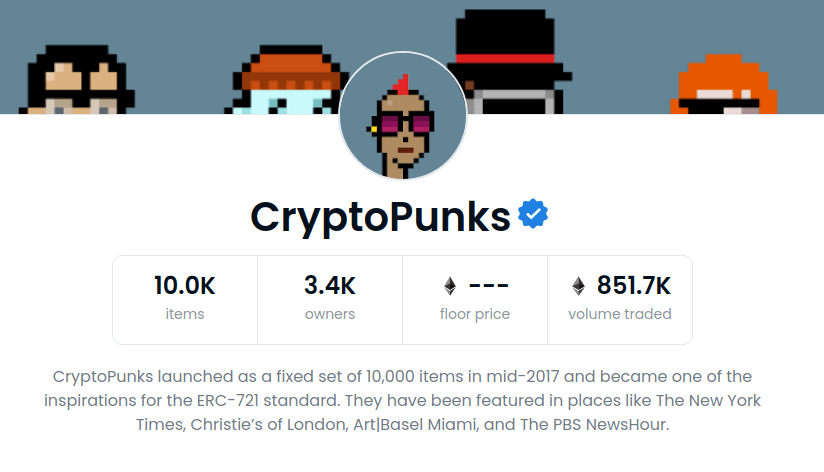
67. PAPER HANDS
Paper hands refer to a person who nervously holds on to their NFTs or cryptos and panic sells them too early.
See also “diamond hands” earlier in this list.
68. PEER-TO-PEER (P2P)
Peer-to-peer or P2P means the direct exchange of an asset between two parties without involving a central authority in the process.
A peer-to-peer network is a network of computers or devices where each computer has an equal say. In other words, all the permissions and responsibilities for data processing are equally distributed.
There is no central authority on a P2P network.
The driving force of the development of Bitcoin was to allow peer-to-peer exchanges of currency.
69. PLAY-TO-EARN (P2E)
Play-to-earn games pay players based on their skill level.
These payments are NFTs that a player can collect and sell for cryptocurrency or real money.
This new form of gaming is a great incentive for new players to give the game a try. Furthermore, this opens up new gaming career opportunities for the players.
70. POLYGON
Polygon is a scalable solution for the Ethereum blockchain. It allows payment transactions that are:
- Cheaper
- Faster
- More secure
Solutions like polygon exist due to the fact that the Ethereum network has become increasingly slow as it has gained popularity.
71. PRIVATE KEY
A private key is a secret number given to a user.
It is similar to a password.
A user can use the private key to:
- Access digital funds.
- Prove ownership.
- Sign transactions.
Do not share your private key with anyone!
72. PROJECT
In the NFT space, the project refers to digital art or digital assets related to an overall roadmap.
An NFT collection is a project.
NFT creators typically share a roadmap for their idea. This is to help enthusiasts understand what is the purpose of the underlying project.
“What projects are you into?”
73. PROOF OF STAKE (POS)
Proof-of-stake is another consensus mechanism for adding blocks to a blockchain.
This is also one form of mining crypto.
In PoS, a miner has a greater chance of winning an additional block if they have more money. In essence, the PoS relies on the amount of stake a user has.
PoS is an alternative to PoW (read below) that is the original consensus mechanism to validate and add new blocks to a blockchain.
It is argued which one, PoS or PoW, is the greater option to maintain the integrity of a cryptocurrency.
74. PROOF OF WORK (POW)
Proof-of-work is a consensus mechanism for adding new blocks to a blockchain.
A consensus mechanism like this is needed because there is no central authority making the decisions.
Proof-of-work literally means proof that someone has done the work to add a block to new a blockchain.
But what exactly is “work” in the proof-of-work mechanism?
In this context, work means using a powerful computer to guess what an encrypted value is.
This is also called mining (read more about mining earlier in this article).
75. PUBLIC KEY
A public key is a shareable key. You can exchange a public key with anyone over a network.
A public key stores information on how to encrypt data.
When it comes to NFTs and crypto, a public key is a cryptographic key that lets other users allow NFTs in your wallet.

76. Public Ledger
A public ledger is used to keep track of records.
It is an old record-keeping system that originates from times way back.
A public ledger was once a physical record, where people wrote information about:
- Prices
- News
- Analysis
And so on.
Anyone could view the public ledger and verify its contents.
Blockchain technology relies on a very similar way of keeping track of transactions.
This is why the word public ledger has resurfaced in the 21st century.
77. PUMP-AND-DUMP
Pump-and-dump is a price manipulation scheme.
The goal of a pump-and-dump scheme is to benefit traders from spikes in prices.
An investor who is seeking to make a profit on crypto might join a pump-and-dump group in hopes of time the spikes right.
Usually, this results in losing money.
Here is how the pump-and-dump scheme works in a nutshell:
- The leader or leaders of the crypto group chooses a crypto coin secretly. Then they gradually buy that coin for some period of time, usually a couple of weeks.
- After the last investment, the leader schedules a “pump day”.
- During the “pump day”, the leader shares the name of the secret crypto they’ve invested in. This causes a massive rush to buy the coin among the group. This momentarily pumps the price up by hundreds of percent.
- Once a price is high enough, the group leader sells all of his positions without warning.
- After a minute or two, the price of the coin is back down and the leader made a profit.
78. QUANTITY
Quantity simply means the number of assets.
79. RARIBLE
Rarible is a popular community-driven NFT marketplace.
80. ROADMAP
Each NFT or Crypto belongs to a project or a business.
Any successful business should have a roadmap for its future.
NFTs and Crypto projects are no different.
NFT and Crypto investors usually want to see the roadmap of the project before investing in it.
81. ROYALTIES
Royalty refers to money earned by the creator of an NFT through resales.
For example, say you create an NFT and set the royalty to 5%. Now every time the NFT is sold or resold, you get a 5% of the selling price.
If the price of the NFT skyrockets years after you sold it, you still get a nice amount of money in the form of royalties.
82. RUG PULL
A rug pull means a crypto/NFT project is abandoned right after the developers of the project generate sales.
A rug pull is hard to detect.
An NFT/crypto project can look promising and the roadmap can look shiny.
But these are just promises.
Once the community has invested in the project by purchasing NFTs or crypto, the owner of the project pulls the rug and ditches the project altogether.
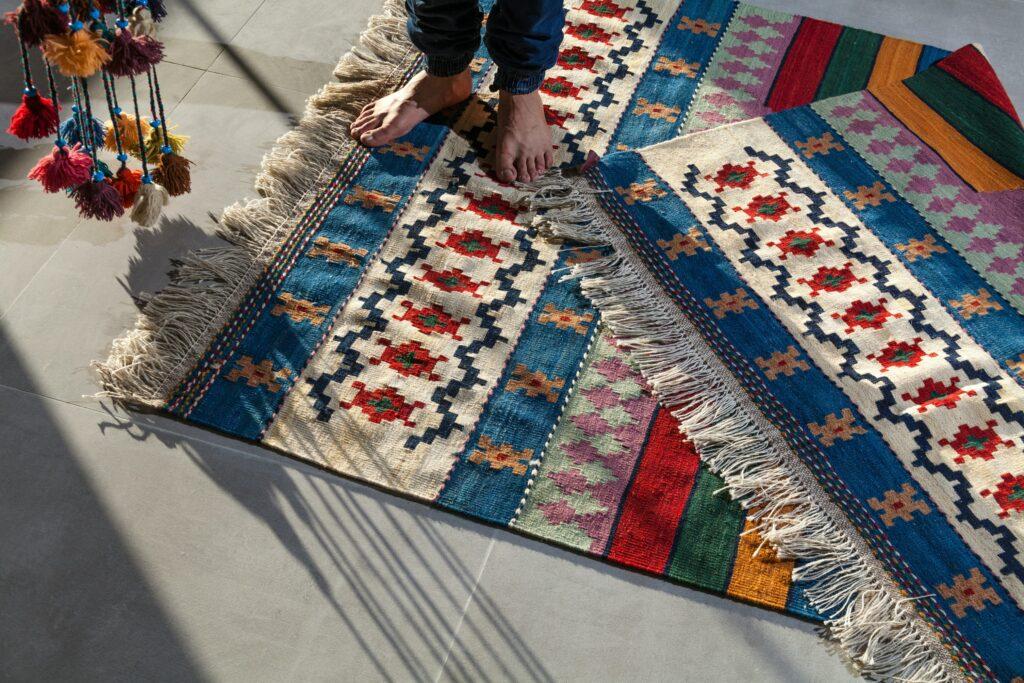
83. SHILLING
Shilling means encouraging others to buy your NFTs for the higher price you purchased them.
This is an exit scam. It usually involves lying or over-optimism.
NFT creators might also do shilling before a rug pull.
84. SMART CONTRACT
A smart contract is a program that is stored on a blockchain. This program runs only when specific criteria are met.
Smart contracts are used to streamline agreements in a way that does not involve an intermediary.
An agreement refers to something we deal with in everyday life, such as:
- Registering a vehicle
- Issuing a ticket
- Sending messages
And so on.
Using smart contracts, both parties can be sure about the outcome of the agreement immediately.
When an agreement has been made, the blockchain gets updated. This transaction cannot be changed. More importantly, only the parties involved in the agreement have the ability to see the result.
85. SOLIDITY
Solidity is a programming language for writing smart contracts.
Solidity is a high-level programming language, similar to Python.
It is optimal for the Ethereum blockchain which is the host for most of the NFTs.
86. STAKING
Staking means depositing a specific amount of crypto and agreeing not to withdraw it for an agreed amount of time.
Staking is an integral part of approving transactions and thus keeping up the blockchain networks.
87. SWEEPING THE FLOOR
Sweeping the floor means buying NFTs on the floor price.
Sometimes NFT investors encourage groups to sweep the floor to raise the floor price of the project.
88. TOKENOMICS
Tokenomics is a playful word that refers to the economics of cryptos, DeFi, or NFTs.
89. TOKENS
A token is a record on a blockchain.
A token gives the owner the right to a specific amount of digital currency or to perform some specific actions with it.
90. TRAITS
Traits are characteristics that make an NFT unique in the collection.
Most of the traits are visual, such as eyewear, hats, and background colors.
If you take a look at a PFP NFT collection, there are no identical NFTs.
The traits and the rarity of the NFTs in a collection are what gives them value.
91. UTILITY-FOCUSED NFTS
A utility-focused NFT is an NFT that has real-world applications.
For example, the Bored Ape grants its owners some privileges, such as access to a collaborative graffiti board.
92. WAGMI
A shorthand for “We all gonna make it”.
This chant describes the future when all of our investments have great positive returns.
93. WEB 3
Web 3.0 is a potentially revolutionary next step on the Internet.
The idea is to decentralize the power of big web authorities to the people.
In Web 3.0 there would be no central authority that controls and knows everything about the users.
Instead, each user of Web 3.0 would be a node like anyone else.
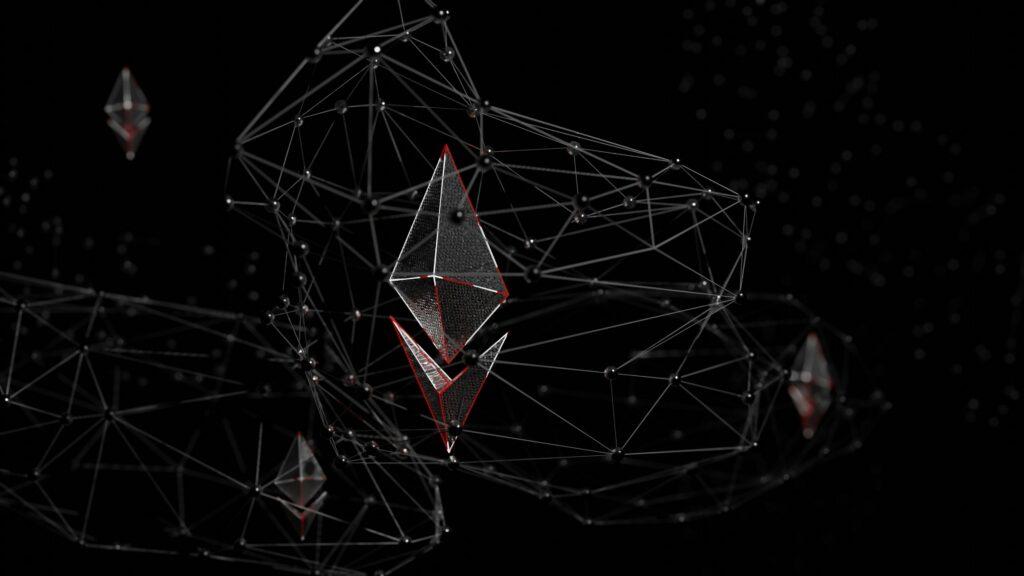
Conclusion
That is a lot of NFT terminology!
I hope you learned a lot of new words and concepts today.
Thanks for reading!